Crocheted ladies with description. Crochet napkins with patterns - simple and beautiful
Now the Lady is standing in profile, holding an umbrella and a dog on a leash.
And now everything is in order and in detail.
The size of the knitted applique is 17 x 21 cm.
Iris threads of different colors, beads for decoration, hook No. 1 were used (for the dog, thicker yarn - LIRA 50 g / 150 m and hook No. 2).
We start by knitting a crinoline (wide skirt) according to this pattern.
Napkin diagram.
We will use 2 repeats with a pineapple pattern. Below in the photo I will show how I knitted the side edges of the skirt.
We start with 7 VP (air loops). Then
1st row: 7 treble s/n,
2nd row: 7 treble s/n, alternating with VP,
3rd row: 5 VP rise, * 4 VP, 4 treble s3n, 4 VP, 1 treble s3n *, repeat from * to * (here I deviated a little from the diagram, the photo shows how to distribute the columns).
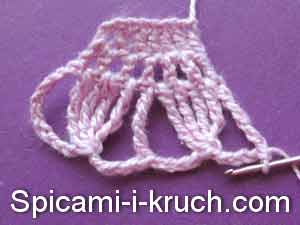
4th row: 4 arches from 6 VP, extreme (6th) arch: 3 VP and treble s/n.
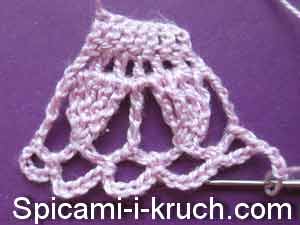
5 row: 3 VP lifting, 2 treble s/n, 2 VP, 1 treble s/n, 2 VP, 1 treble s/n, 2 VP, 3 treble s/n, 2 VP, 3 tbsp. s/n, 2 VP, 1 senior s/n, 2 VP, 1 senior s/n, 2 VP, 3 senior s/n.
6th row: 3 VP lifting, 2 treble s/n, 4 VP, 1 treble s/n, 4 VP, 3 treble s/n, 2 VP, 3 treble s/n, 4 VP, 1 tbsp. b/n, 4 VP, 3 st.s/n.
![]()
We also start the 7th and 8th rows with 3 VP lifts and 2 treble s/n.
9 row: 3 VP lifting, treble s/n, 2 VP, 3 treble s/n and further according to the pattern.
10 row: 3 VP lifting, 2 VP, 3 treble s/n, 2 VP, 3 treble s/n, etc.
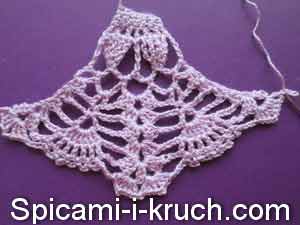
11th row: 3 VP lifting, 1 VP, 1 treble s/n, 2 VP, 3 treble s/n, 2 VP, 3 treble s/n, etc.
12th row: 3 VP lifting, 3 VP, 1 treble s/n, 3 VP, 3 treble s/n, 2 VP, 3 treble s/n, etc.
13th row: 3 VP lifting, 5 treble s/n, 4 VP, 3 treble s/n, 2 VP, 3 treble s/n, etc.
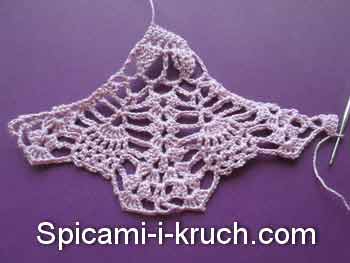
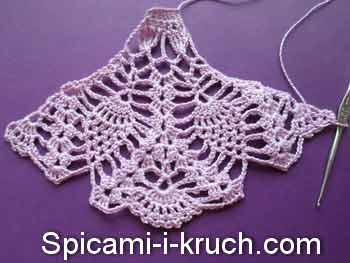
We knit according to the pattern until the 16th row. It turned out to be 2 wedges of napkins.

Take a thread of a different color and tie the lower edge of the skirt with arches of 3 VP and double stitch.

In the next row we knit beads. To do this, we knit a double stitch, VP, into an arch, put a bead on a hook, grab a loop and pull it through the hole of the bead.
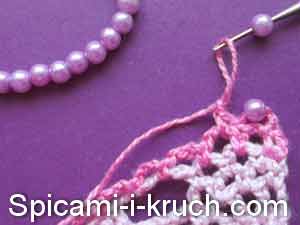
Then we make VP and dc in the same arch.
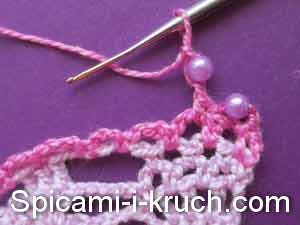
Now we knit the Lady’s torso and neck.
Hands: since the Lady is standing sideways, we knit one hand completely and the other half.
We start with the palm: do 3 VP, then 3 VP lifting and 2 treble s/n, each next row also start with 3 VP lifting.
In the place of the elbow bend, knit 3 VP lifting, 1 half treble s/n, 1 treble crochet. Next, expand your hand by adding 1 treble crochet in each row.

I knitted a knitted applique hat according to the pattern from the article ““

For the umbrella, I knitted a semicircle with the most common stitch, alternating double crochets and VP. The handle of the umbrella is a chain of VP and 1 row of half double crochets.

I knitted a dog for the first time and took thicker yarn for it so that it would be better visible in the photo.
Knitted 3 VP,
then 1 VP lifting, 3 half-columns (this will be the tail of the dog), 7 VP,

1 VP lift, 7 half double crochets (back leg - 4 sts and torso - 3 sts).
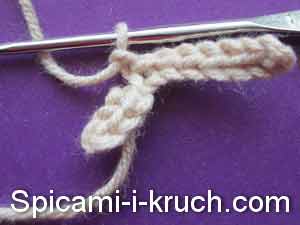
1 VP lifting, 3 semi-st.b/n (torso), 4 VP (leg),

1 VP lifting, 7 semi-st.b/n.
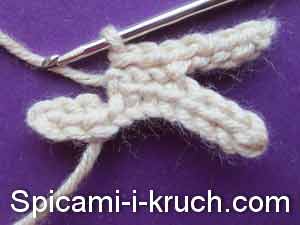
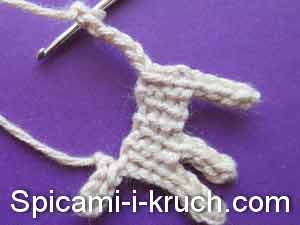
We tie the second front paw, then the second ear

and a muzzle.

for the knitted applique Dog, you can use black thread to make the nose and eyes, as well as leash and collar.
This is the kind of dog I got.

For a long time, a television, carefully covered with a napkin, remained one of the main attributes of any Soviet housing. Times are changing, and now it is rare to see a woman who decorates her home with knitted napkins. However, seeing such a decoration in someone else’s house, each of us admires the talent and skill of the craftswoman. So why not continue the tradition of knitting beautiful things that will bring new, interesting accents to your home? Crochet napkins– what could be simpler? Especially if there is an article with diagrams- things work out simple but very beautiful!
How to understand a knitting pattern?
Crocheting napkins using a crochet hook is really simple, but the working pattern is not always clear. We invite you to look at this picture - the main symbols that are most often used when weaving are deciphered here.
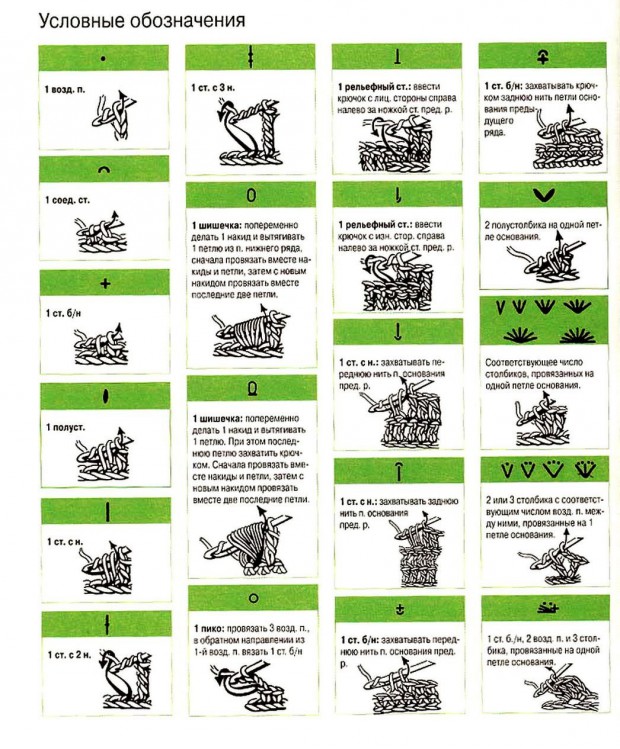
Knitting in circles
The simplest and most classic knitting is circular weaving. The patterns of such napkins, as you can see, are very simple - the main thing is to know symbol and have at least some experience.
As you can see, many patterns with German text are an echo of those times when it was possible to find a way to knit a beautiful thing only in German magazines. And now such napkins can be knitted using patterns from the Internet - what could be more accessible and simpler?

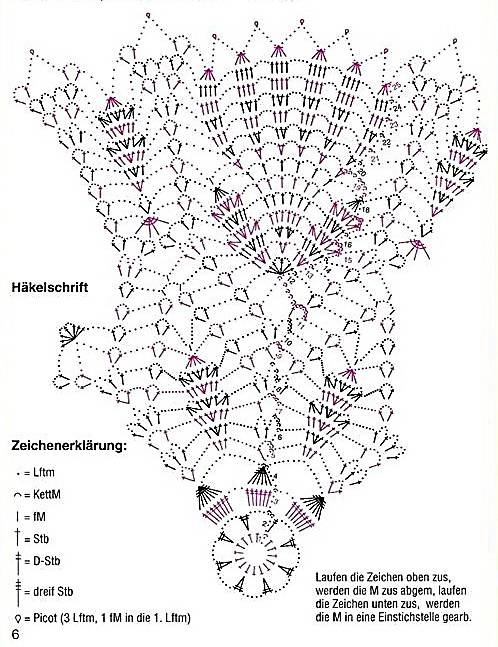

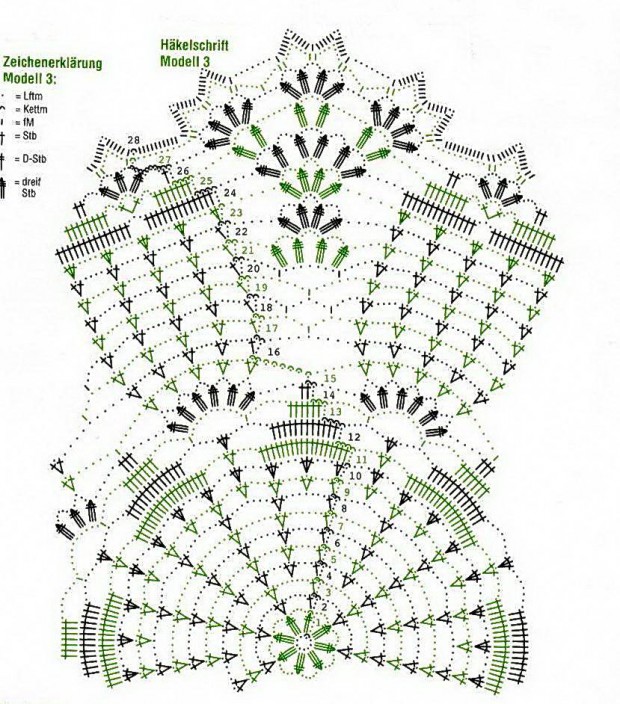
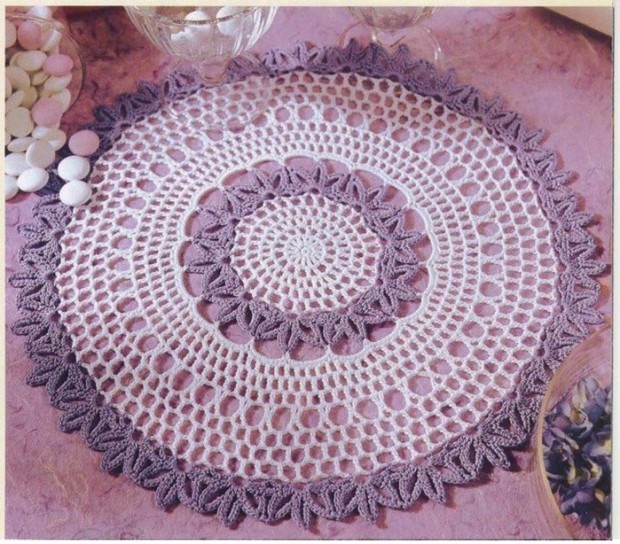
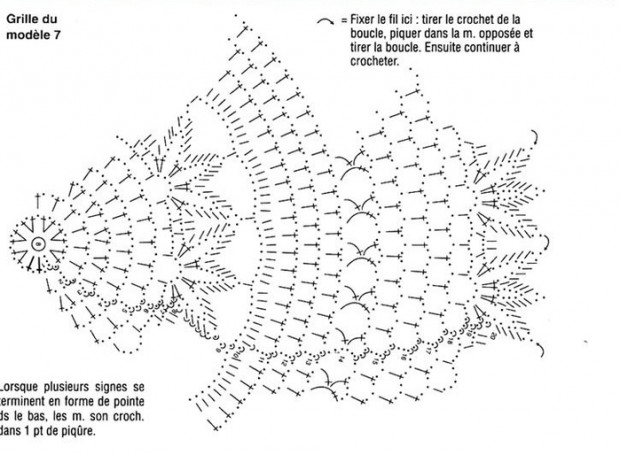
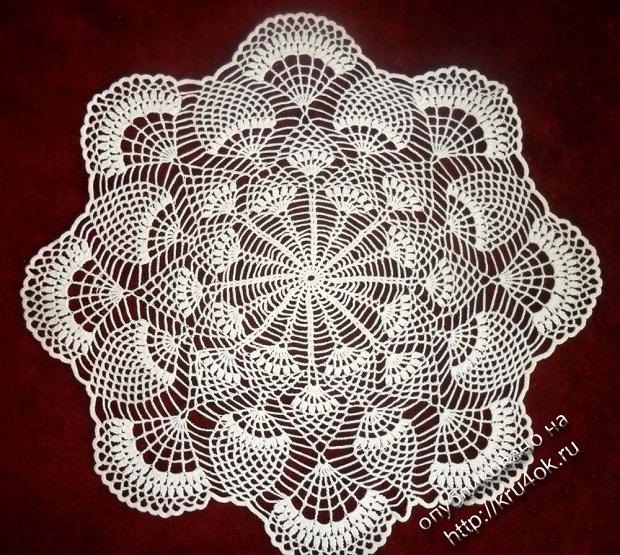
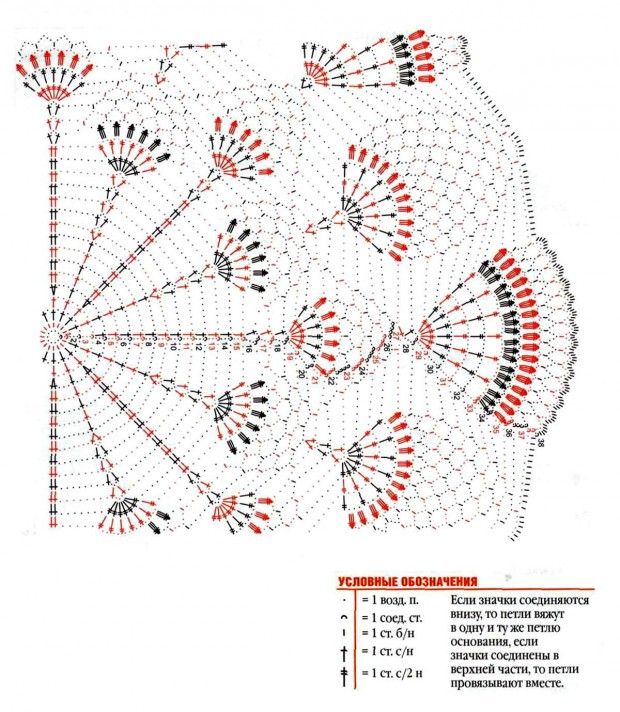
By the way, many needlewomen use patterns for knitting lace doilies to create interesting and unusual large items - for example, tops or dresses.
Figured napkins
DIY knitting crocheted napkins with patterns taken from our article will be excellent, simple and beautiful solution for non-standard surfaces. After all, it often turns out that you need to decorate part of a piece of furniture. A round napkin has its drawbacks, and then you should pay attention to such figured things. They are the ones who show your taste and ability not only to knit, but also to decorate the surrounding space.
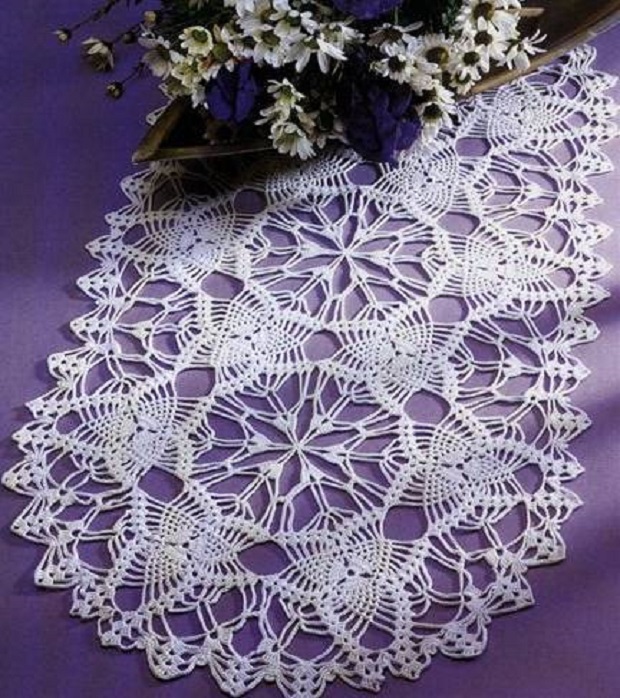

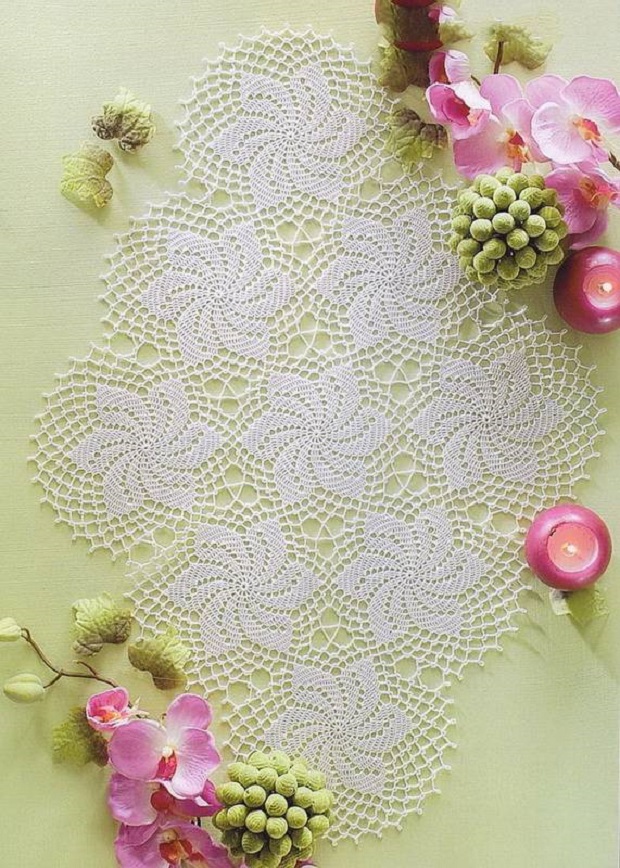
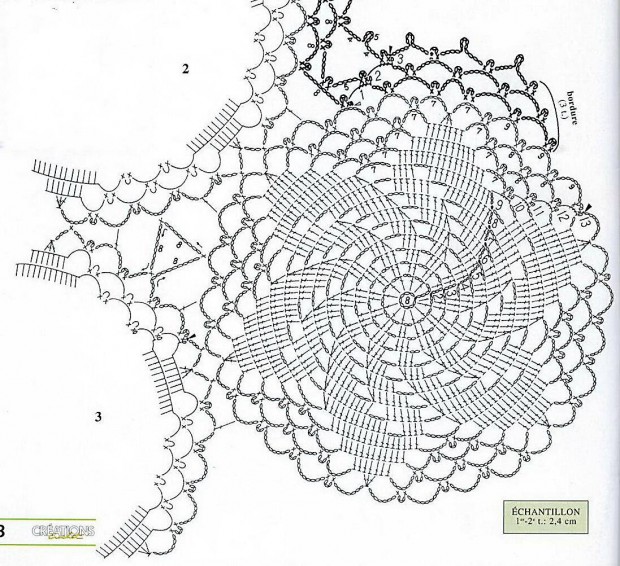

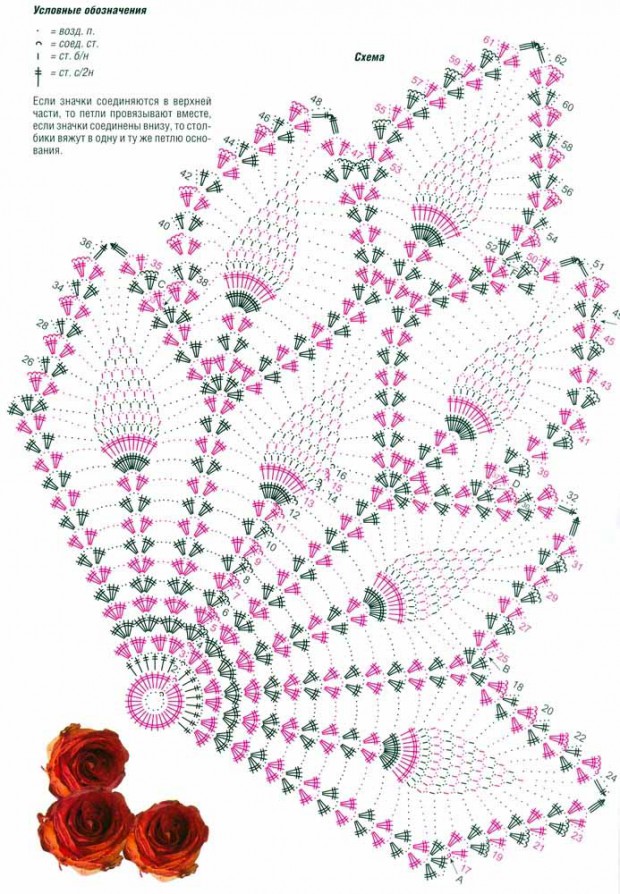
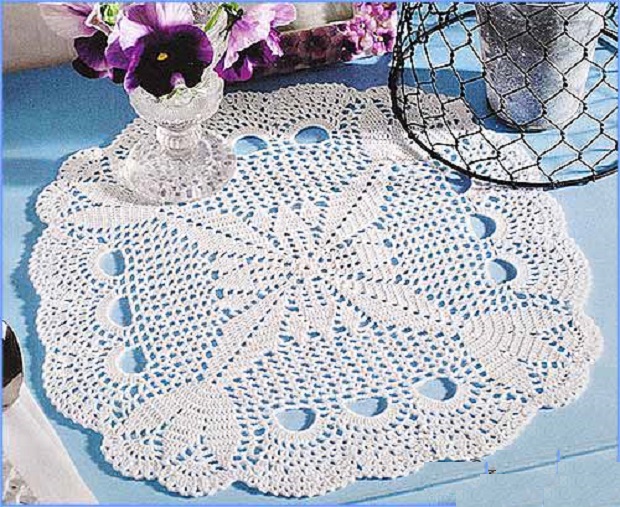
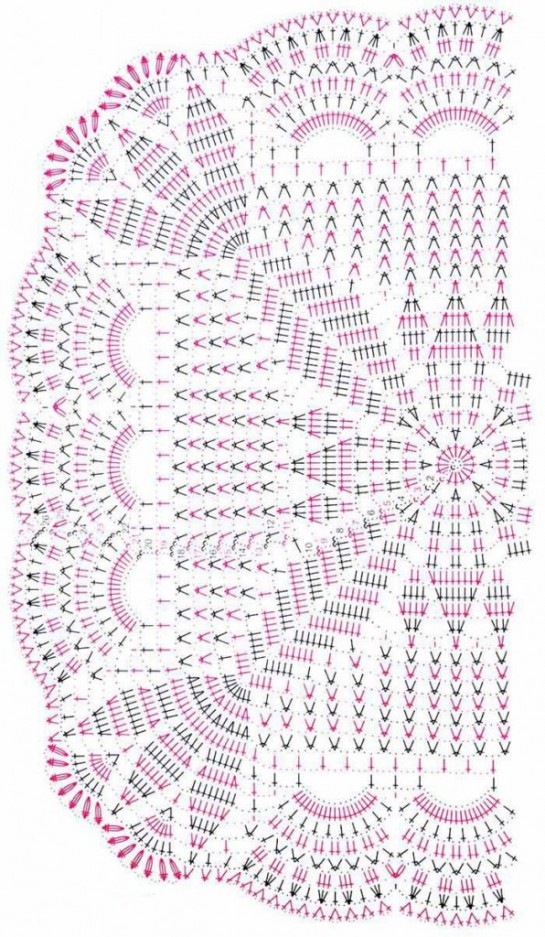
Patterns for napkins in the style of fillet knitting
Using a hook you can knit such unusual, but incredibly beautiful napkins:
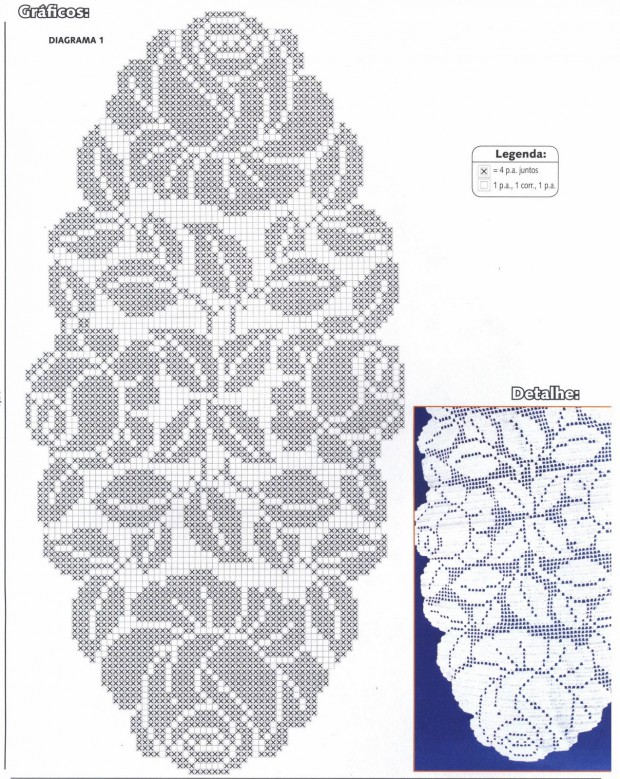
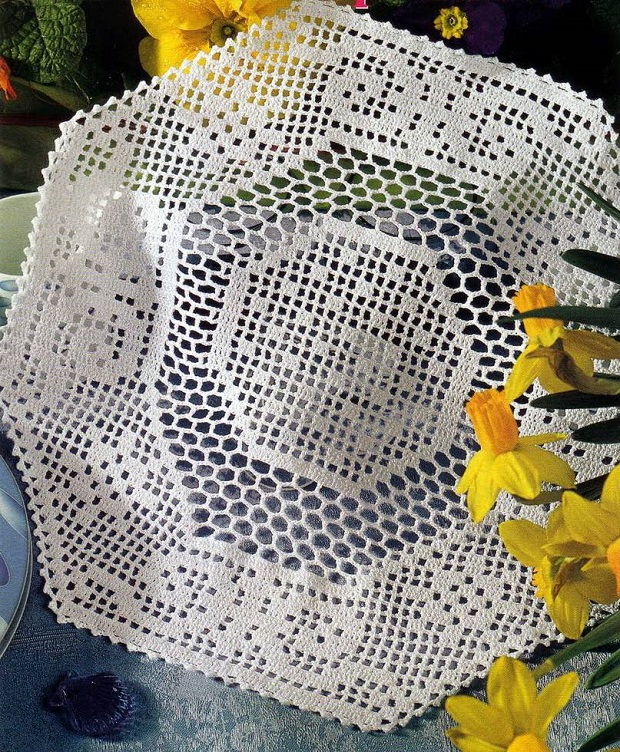

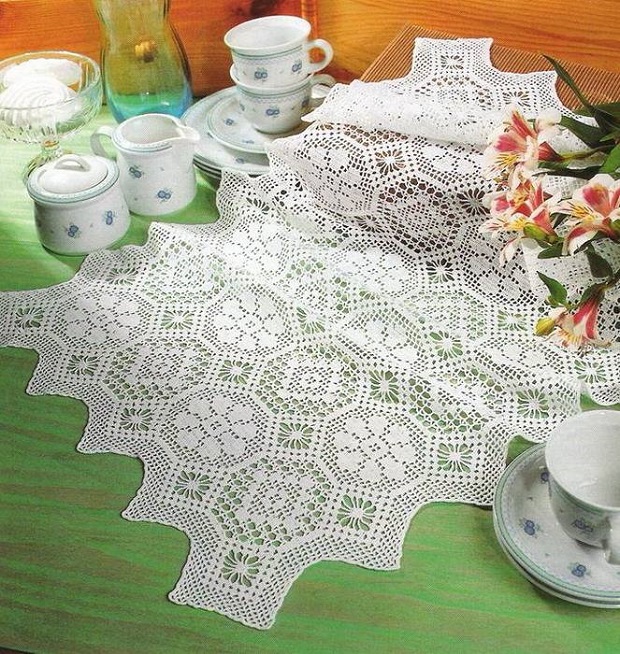

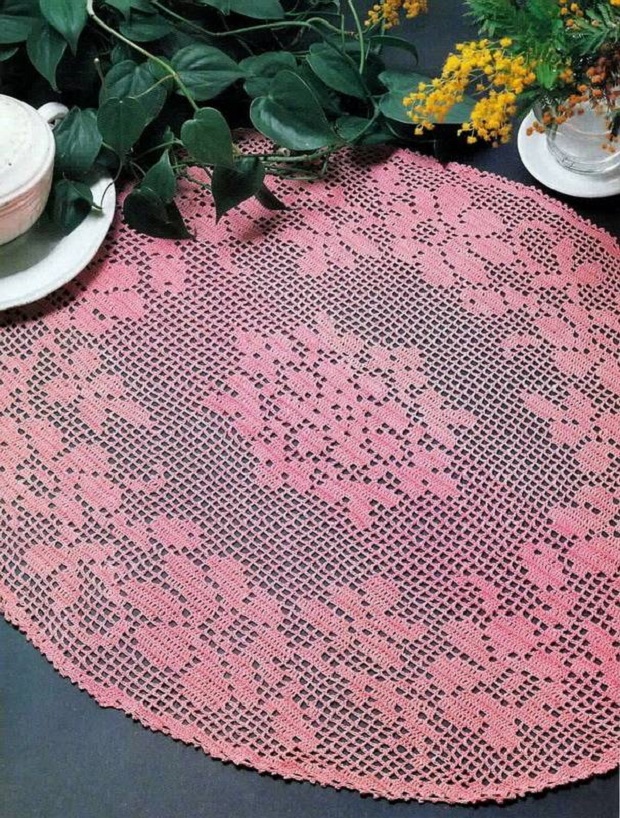
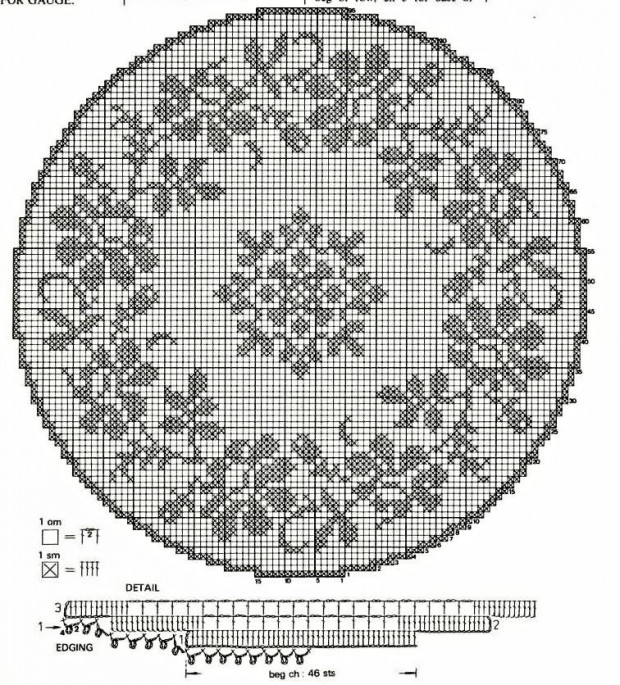
Experienced knitters know that this technique is called “loin knitting” and any item is knitted very quickly and simply, although you cannot tell this by the excellent result. Amazing job! Try to surprise your family and guests by decorating your home with these napkins.
Bruges lace for napkins
There is such an interesting way of knitting napkins using a hook. Of course, this will not be easy for beginners, but more experienced craftswomen can easily find master classes describing this technique on the Internet. We suggest you admire the options for napkins that you can knit yourself (and they look as if they were machine knitted!). For lovers of Bruges lace, we also offer quite simple patterns.
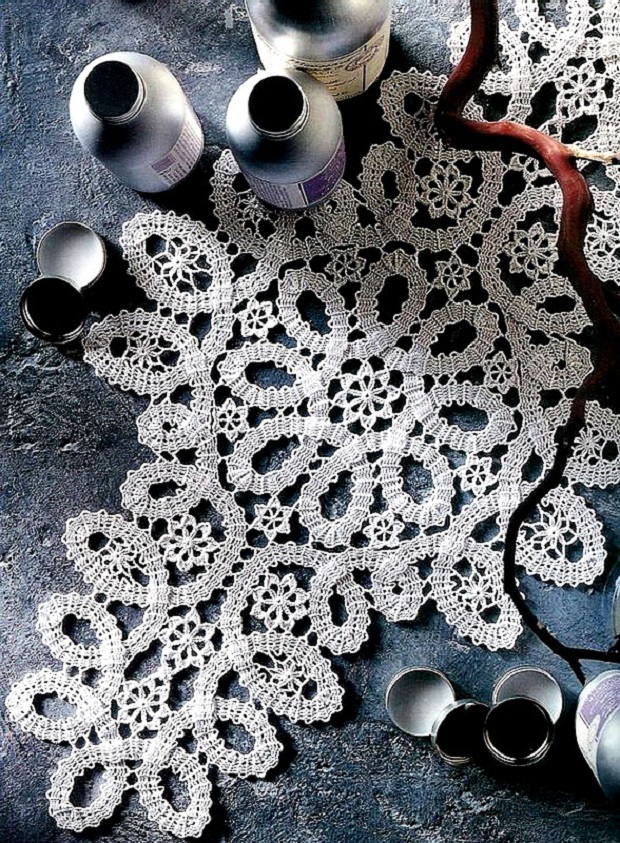

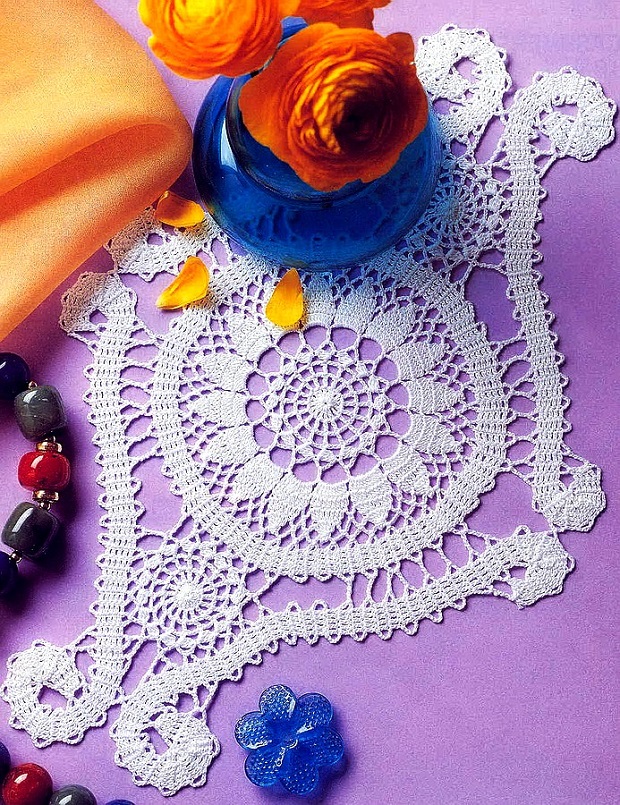

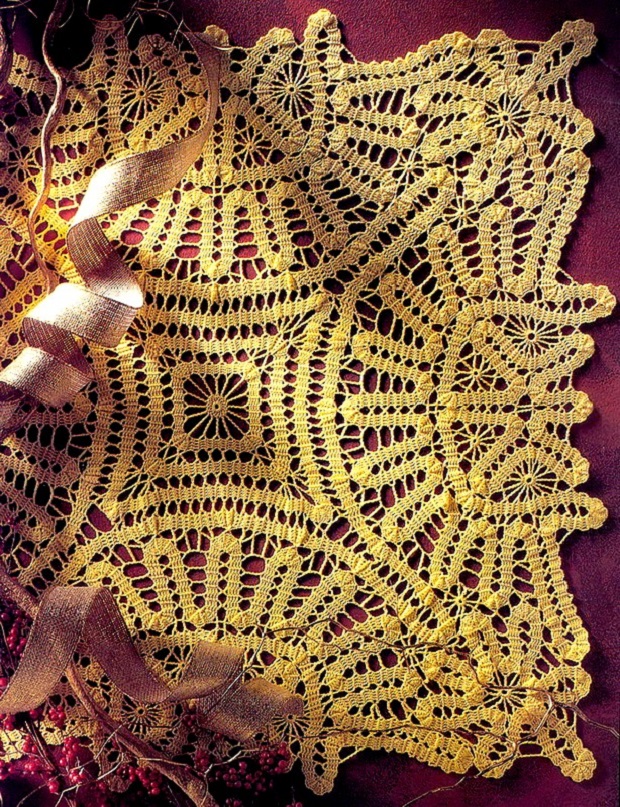
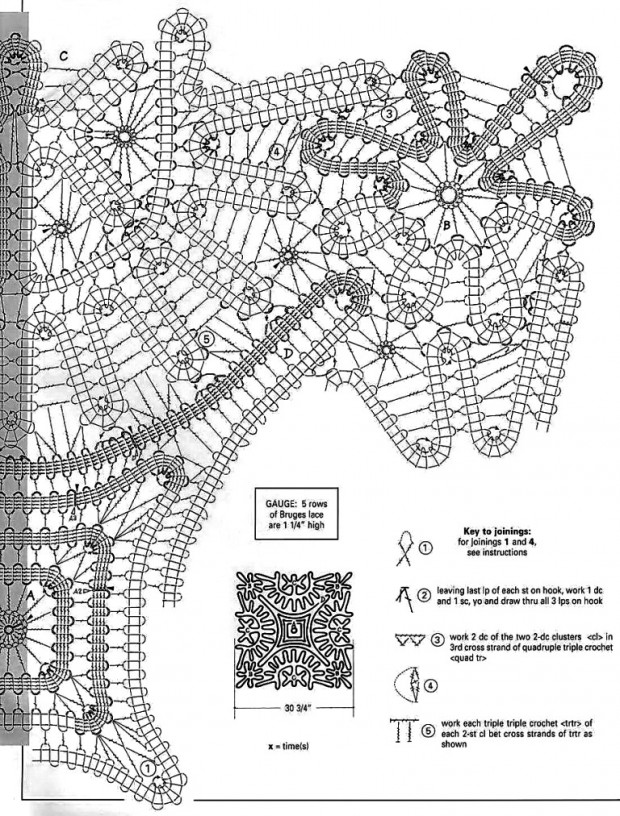
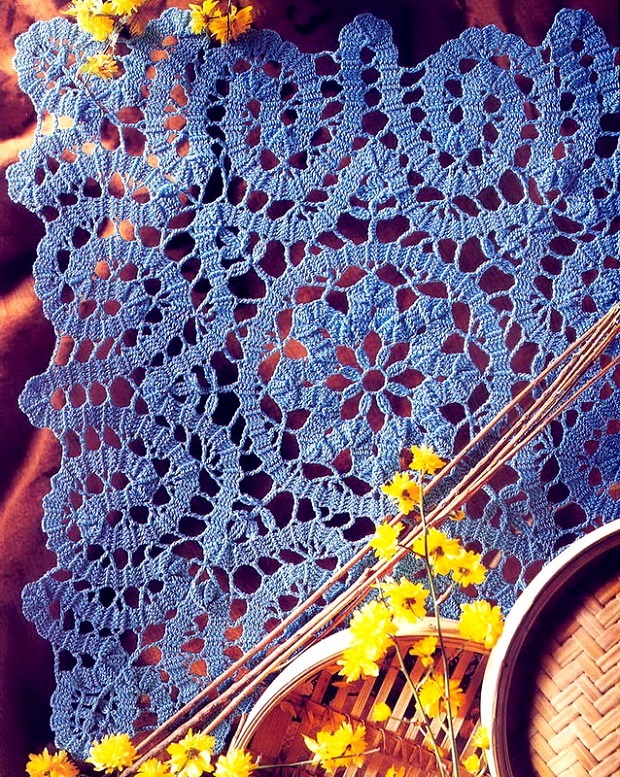

Napkins with the spirit of Ireland
We have already told you a little about Irish lace . Crochet napkins with patterns knit using this technique Just, but the thing turns out very beautiful. Such natural motifs will be an excellent addition to any interior.
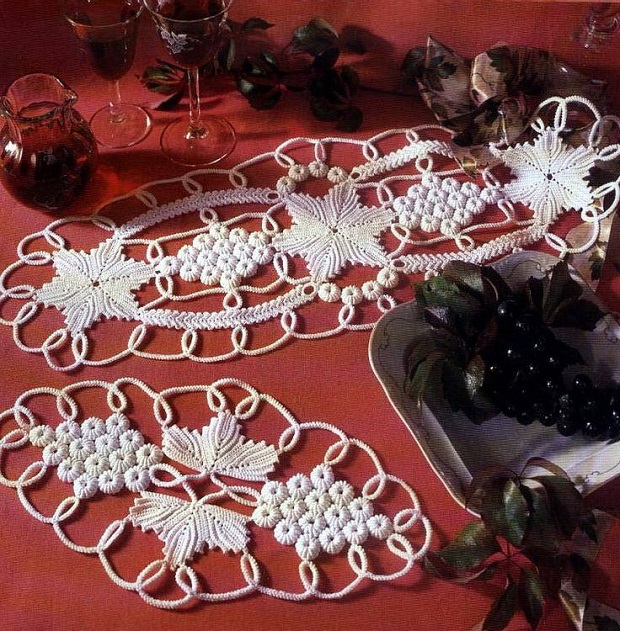
Crocheted napkins are an integral part of everyday life in your beloved home, where it is always cozy and warm. You can give such associations to your loved ones by learning how to crochet napkins. They can be connected both according to classical motives and in a modern way, in the most unusual ways. They can be of any fancy shapes and patterns - from delicate delicate lace details, to strict minimalism of lines and interweaving of threads.
Both experienced needlewomen and beginner knitters are working on crocheted napkins with interest. Patterns for crocheting napkins will interest all housewives without exception, and the finished product will not leave anyone close to you indifferent. Remember that crocheted napkins are not only a beautiful decoration, but also original gift for the long memory.
Beautiful crochet napkins - patterns with descriptions
Let's begin to study the options for crocheting these airy products, the main property of which is to keep the home cozy. And the diagrams and detailed descriptions progress will make this task much easier for us.
It should be noted right away that beginners should not be afraid complex circuits and descriptions. Crocheting napkins for beginners is quite accessible, the main thing is that in order to learn faster, you need to choose several simple knitting options to start with. Let's start with simple examples crochet, after which we will consider more complex, but certainly interesting options for knitting napkins.
Simple
Where to start crocheting napkins is with simple weaves, loops and rings, which will help you quickly get the hang of it and move on to more complex and interesting patterns for knitting these lovely products.
Floral motif

If we talk about knitting for beginners - simple napkin crochet with floral motif - always good idea. The diameter of our future napkin is 15 cm. It is suitable as a decoration for any part of the house.
Yarn
— YarnArt Jeans of a suitable color -12 g, 50 g – 160 m;
Hook
— №2.
StBN
– single crochet;
StSN
– double crochet;
SSt
– connecting column;
VP
- air loop;
PStSN
- half double crochet.
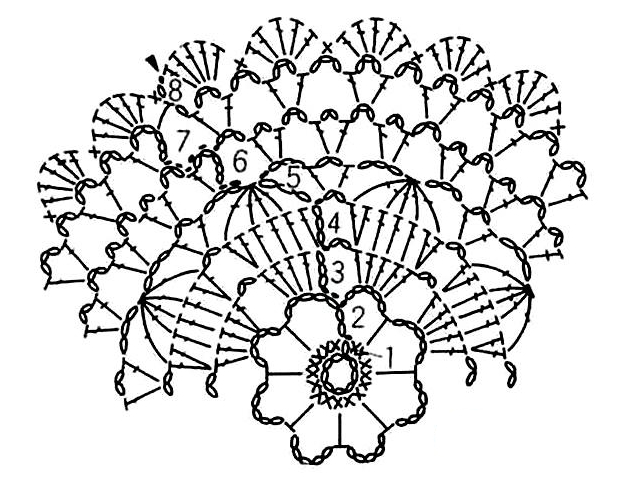
We collect a chain of 8P. We connect them into a ring and step by step follow the further work scheme.
1st row:
1 VP, 16 StBN, SSt;
2nd row: At the beginning of knitting, we replace the stitches with the corresponding number of VPs. *1PStSN, 5VP* x 8;
3rd row: knitting under arches from 5 VP. sst * 5 stsn, 2 VP * x 8, sst;
4th row: in the next five columns of the previous row we knit like this: * 2 Sts, 3 Sts, 2 Sts, 2 VP * x 8, St;
5 row: skipping the 2nd and 6th stitch, we knit 5 dc with one base, 3 ch, under 2 ch – 1 dc, 2 ch, 1 dc* x 8* dc;
6th row: under all the arches from VP we knit *1 StS, 2 VP, 1 StS, 3 VP* SSt;
7th row: we start by knitting a DC under the arch and knit *1 DC, 3 VP, 1 DC, 3 VP*, skip one arch and repeat knitting from * to *. We finish the row - 1 VP, 1 PstSN;
8th row: *1 stbn under the arch, 5 stsn under the next one*, st.
We cut the thread and fasten it.
Sunny lace
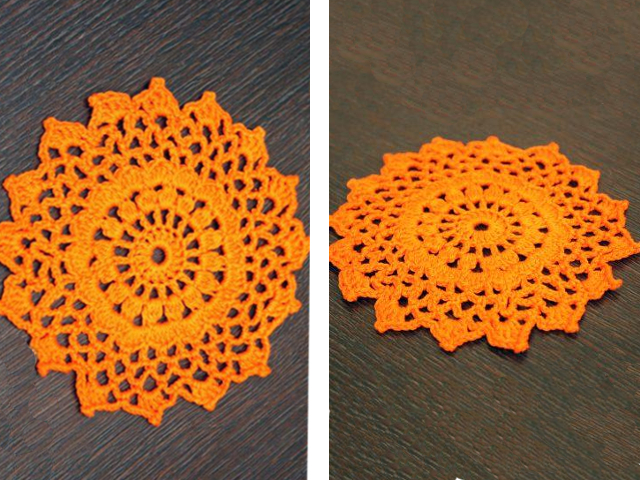
Our napkin is perfect for vases, cups or glasses. Its diameter will be 12.5 cm.
Preparing to knit a napkin:
Yarn
— Narcissus (100g – 395m, 100% mercerized cotton);
Hook
— №2.
Abbreviations for the diagram:
CCH
– single crochet stitch;
VP
- air loop;
JV
– connecting loop;
Pico
– 3 VPs connected by a joint venture into the first loop;
RLS
- single crochet.
Knitting pattern and description of how to crochet a napkin:
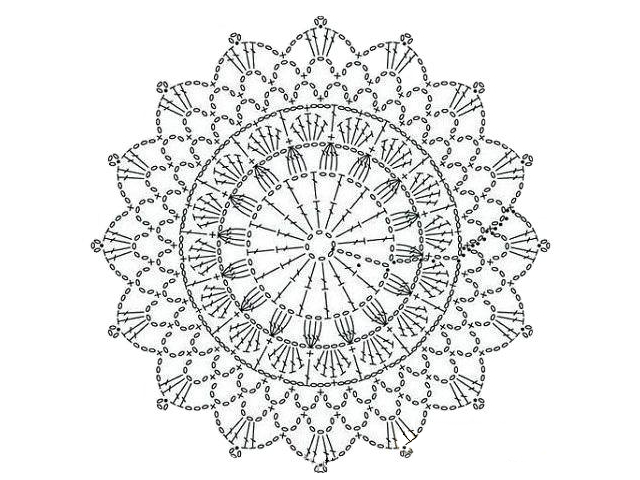
8VP, SP.
1st row: 3VP, knit 15 DC in a circle, SP in 3rd VP;
2nd row: 5VP, *1DC in the DC of the previous row (PR), 2VP*, SP in the 3rd VP;
3rd row: We knit 1SP in the 4th VP, 3VP and 3DC with one common vertex - in the PR arch, 4VP, * 4DC with a common vertex in the PR arch, 4VP*, SP in the 3rd VP;
4th row: 1VP, in the common top 1СБН, *in the arch of the previous row 5СН, 1СБН in the common top*, SP in the SC;
5 row: 3VP, *3VP, 1SC in the 3rd SC of the previous row, 3VP, 1DC in the SC of the previous row*, SP in the 3rd VP;
6th row: 2SP in 4-5VP, *1SC in arch, 5VP*, SP in SC;
7th row: 4SP, *1sc in arch, 5VP*, sp in sc;
8th row: 4SP, *1SC in the arch, 3VP, in the arch (2DC, pico, 2DC), 3VP*, SP in the SC.
Oval
Oval napkins are associated with the comfort and warmth of grandma's house. There were sure to be a few crocheted elongated oval-shaped napkins that were lovingly passed down from generation to generation. The time has come for us to learn how to knit such family heirlooms.
Napkin “Nostalgia”
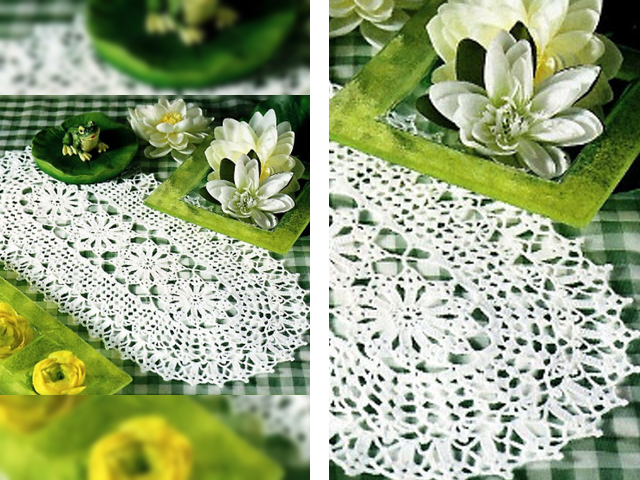
An oval crocheted napkin with diagrams and descriptions will help you crochet great gift close people who will definitely remember with nostalgia something pleasant from the past. After all, such napkins are associated with warmth and comfort.
The size of our napkin is 24×46.
Preparing to knit a napkin:
Yarn
— Cotton white (50 g – 208 m, 100% mercerized cotton);
Hook
— № 1,5 — 1,75.
Knitting pattern and description of how to crochet a napkin:
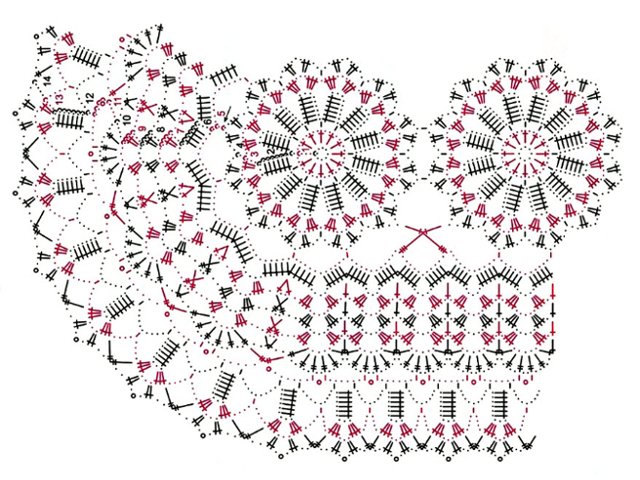
For the socket, knit a chain of 8 chain stitches and close it with 1 dc into a ring. Next, knit in circular rows according to the pattern. Tie 4 rosettes, connecting them together in the last row. Attach the thread at the arrow in knit around the rosettes in circular rows according to the pattern.

Napkin “Lacy Waltz”

Another classic style crocheted oval napkin.
Preparing to knit a napkin:
Yarn
— Iris threads in pink and blue colors (100% cotton, 25 g/150 m); white yarn (40% cotton, 60% viscose, 100g/400m);
Hook
— № 1,15.
Knitting pattern and description of how to crochet a napkin:
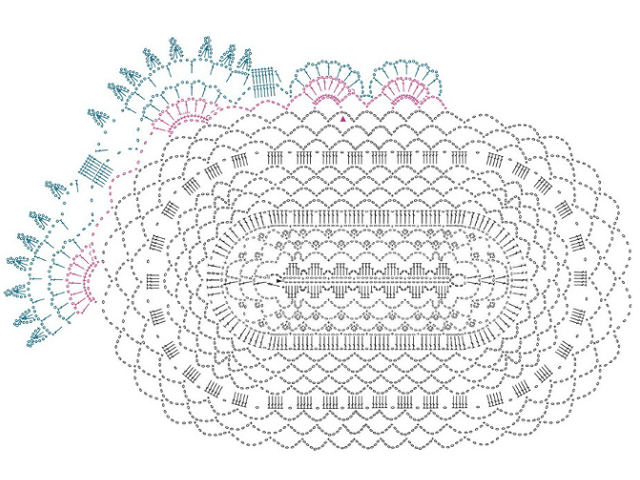
Step 1: Cast on 45 chain stitches, then single crochet in the 10th loop of the chain and then crochet 5 ch and dc in the 6th loop of the chain, according to the diagram (photo 1).
Step 2: Having knitted a connecting stitch at the end of the 1st row, start knitting a single crochet, a half double crochet, 3 double crochets, a half double crochet, a single crochet into each arch. Between these elements knit 2 VP. Having tied the lower side, knit a ring of 8 VPs, continue tying the upper part. At the end of this row, knit 4 VPs and a double crochet stitch in the VP of the first row. You will get a ring, just like the other end (photo 2).
Step 3: In the third row, knit arches of 5 or 6 VPs according to the pattern (photo 3).
Step 4: Then knit 2 rows of arches and picots from 3 VPs (photos 4 and 5).
Step 5: In the 6th row, alternate chains of 5 VPs and single crochets in the middle of the arches of the previous row (photo 6).
Step 6: Knit 5 double crochets into each arch, separating from VP (photo 7).
Step 8: Work another row of double crochets, separated by VP (photo 9).
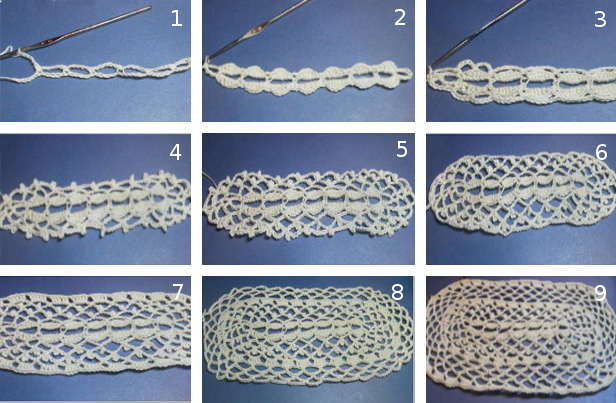
Step 9: Then follow 3 rows of 7 VP (photo 1).
Step 10: Let's start knitting with pink thread. In the diagram, the beginning of this row is indicated by a pink triangle. We knit an arch from 7 VP, then dc and turn the work (photo 2).
Step 11: Place 14 double stitches into this arch in the opposite direction (photo 3).
Step 12: Let's turn the work around again. We knit 3 VP rises, * 2 VP, senior s/n*, repeat from * to * 7 times. Continue knitting according to the pattern (photo 4).
Step 13: When you knit the next such element, instead of 3 VP rises, knit 3 connecting stitches, turn the work, and continue crocheting the napkin according to the pattern (photo 5).
Step 14: Finishing this row, tie 4 VP and connect. column (photo 6).
Step 15: Now knit with blue thread in accordance with the pattern (photo 7).
Step 16: Increase the number of VPs between double crochets (photo 8).
Step 17: In the last row, knit 3 VPs, 3 double crochets with a common top, a picot of 5 VPs, 3 VPs into each arch (photo 9).

Round
Round napkins are the most popular type among all possible crocheted napkins. The variety of designs and patterns impresses both beginners and experienced craftswomen. Let's consider several options for knitting patterns with descriptions.
Napkin “Winter's Tale”

The diameter of the future round napkin will be 20 cm.
Preparing to knit a napkin:
Yarn
— Narcissus (100% mercerized cotton, 100 g – 395 m);
Hook
— №2.
Abbreviations for the diagram:
JV
– connecting loop;
VP
- air loop;
CCH
– single crochet stitch;
RLS
– single crochet;
[…] , *…*
- repetition;
ETC
– previous row;
A
– common vertex, i.e. 2 dc are knitted together;
Pico
– 4VP and 1СБН in the first VP.
Knitting pattern and description of how to crochet a napkin:
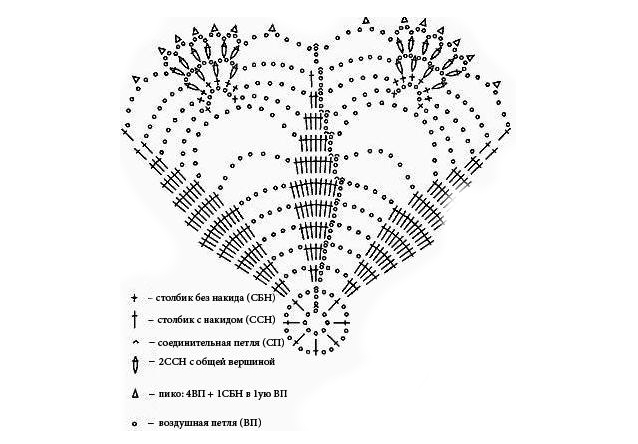
8VP, SP.
1st row: 5VP, *1DC, 2VP*, SP in the 3rd VP; Starting from the second row - at the beginning of each row we knit 3VP.
2nd row: to the beginning of the row another 2DC, *3VP, 3DC in 1DC PR*, SP in the 3rd VP;
3rd row: 2Dc in each Dc PR, *4VP, 5Dc (2Dc in the outermost Dc and 1Dc in the middle)*, SP in the 3rd VP;
4th row: 6dc (2 dc in each dc in the outer dc in the middle and 1 dc in the middle), * 4 ch, 7 dc (according to the same pattern as in the 3rd row - adding 1 dc for each free dc in the middle) *, sp in the 3rd ch ;
5 row: 8DC (according to the 4th row pattern), *5VP, 9DC (according to the 4th row pattern), SP in the 3rd VP;
6th row: 10СН, *6VP, 11СН*, SP in the 3rd VP + 1SP;
7th row: 8DC (leaving 1DC PR free at the end), *8VP, 9DC (leaving 1DC free on both sides) – we form a rhombus, SP in the 3rd VP + 1SP;
8th row: 6SSN, *13VP, 7SSN*, SP in the 3rd VP + 1SP;
9th row: 4СН, *6ВП, (1СБН, 6ВП, 1СБН) – in the middle of the arch, 6VP, 5СН*, SP in the 3rd VP + 1SP;
10th row: 2СН, *6ВП, in a small arch 6СНБ, 6ВП, 3СН*, SP in the 3rd VP + 1SP;
11th row: 1СН, , joint venture in the 3rd VP;
Row 12: 4VP, pico, SP in the 3rd VP.
Napkin “Tenderness”

A more complex version of the round napkin, but the end result will definitely please you. The finished crochet product will be 36 cm.
Preparing to knit a napkin:
Yarn — Pekhorka “Successful” of blue color, 100% mercerized cotton (50 g -220 m);
Hook — №2.
Abbreviations for the diagram:
StbSN
– double crochet;
VP
- air loop;
Pet
- a loop.
Knitting pattern and description of how to crochet a napkin:
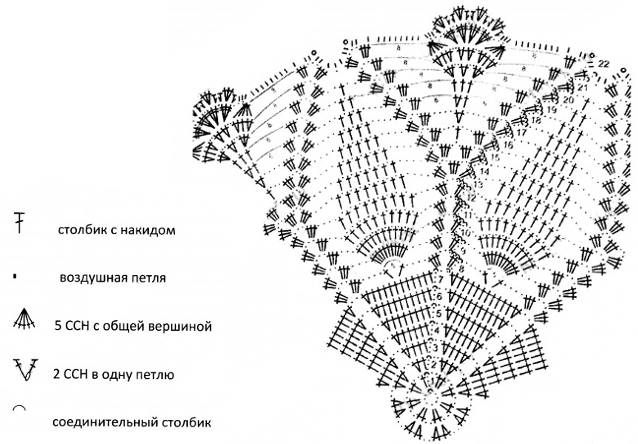
We collect eight VPs and close them in a circle.
Each next row, we begin by knitting 3 VP, which replaces 1 StbSN.
We end each row with a connecting column.
1st row: *2 StbSN, 2 VP* - repeat 8 times;
2nd row: *in each DC of the previous row we knit 2 DC, 2 VP* - repeat 8 times;
3rd row: *2 DC in one stitch, 1 DC in each of the next two loops, 2 DC in one stitch, 2 VP*, repeat until the end of the row;
4th row: *2 DC in one stitch, 1 DC in each of the next four loops, 2 DC in one stitch, 2 VP*, repeat until the end of the row;
5 row: *2 DC in one stitch, 1 DC in the next six stitches, 2 DC in one stitch, 2 VP*, repeat until the end of the row;
6th row: *2 DC in one stitch, 1 DC in each of the next eight loops, 2 DC in one stitch, 2 VP*, repeat until the end of the row;
7th row: *2 DC in one stitch, 1 DC in the next ten stitches, 2 DC in one stitch, 2 VP*, repeat until the end of the row;
From 8 to 22 row knit according to the pattern.
Square
Not a very popular form for crocheted napkins, but also interesting, both visually and in work. Needlewomen can try out several knitting options using the following patterns with descriptions.
Napkin “Pineapple Fantasy”
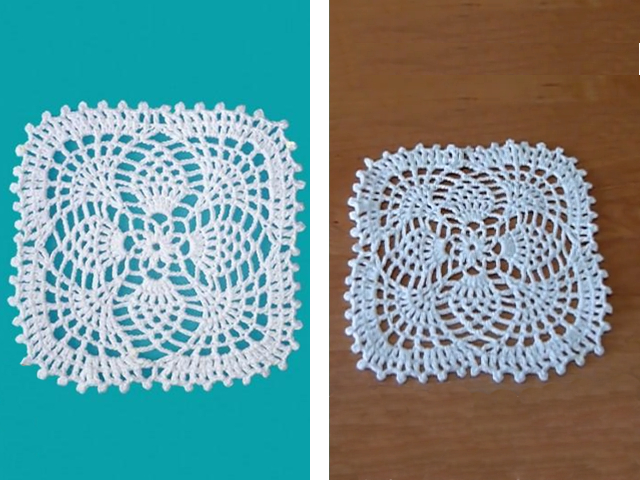
Preparing to knit a napkin:
Yarn — white YarnArt Jeans, 55% cotton, 45% acrylic (50 g -160 m);
Hook — №2.
Abbreviations for the diagram:
CCH
– double crochet;
RLS
– single crochet;
VP
- air loop;
С3Н
- double crochet stitch;
JV
– connecting loop.
Knitting pattern and description of how to crochet a napkin:
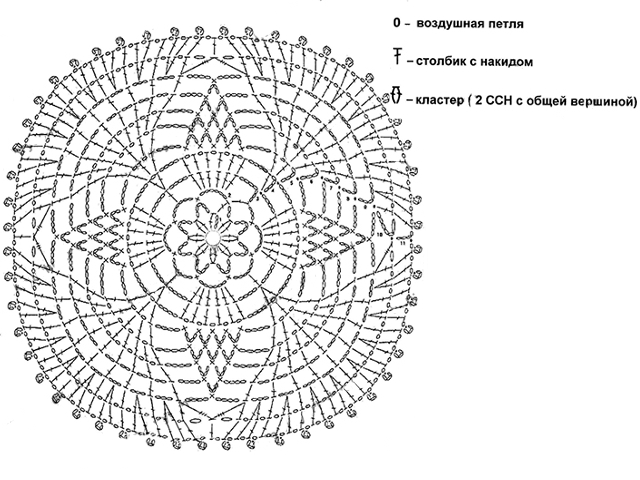
Important: when further knitting, do not forget to replace the lifting 3 VPs with 1 SSN. Knit according to the description, but look at the diagram so that all the points in knitting are clear.
1st row: we start with a sliding loop and inside the ring we knit 3 VP, 1 Dc, 5 VP, * 2 Dc with a common top (cluster), 5 VP; repeat six more times. At the end of the row, instead of five VPs, we knit 2 VPs and 1 DC in the initial cluster. The result was eight arches from five VPs;
2nd row: *6 VP, sc under the next arch of five VP; repeat from * to the end of the row, end the row with three VPs and 1 dc in the dc column of the first row;
3rd row: 7 VP (equal to 1 Dc + 4 VP) and in the first arch we knit * 6 Dc, 4 VP, 1 Dc under the next arch, 4 VP; repeat from * to the end of the row. We finish the row of joint ventures in the third VP;
4th row: 4 VP (equal to 1 Dc + 1 VP), 1 Dc in the same loop, 4 VP, above each Dc of the third row we knit 1 Dc and 1 VP between the columns, 4 VP, * (1 Dc, 1 VP, 1 Dc) in DC column of the third row, 4 VP, above each DC of the third row we knit 1 DC and 1 VP between the columns, 4 VP; repeat from * to the end of the row. We finish the row of joint ventures in the third VP;
5 row: *4 VP (hereinafter we knit as 1 Dc + 1 VP), 1 Dc under the VP of the fourth row, 1 VP, 1 Dc in a double crochet, 4 VP, 1 RLS under the first VP of the fourth row (4 VP, 1 RLS under the VP ) – three more times, 4 VP; repeat from * to the end of the row. We finish the joint venture in the third VP;
6th row: *4 VP (hereinafter we knit as 1 Dc + 1 VP), 1 Dc under the first VP, 1 VP, 1 Dc in the CH column, 1 VP, 1 Dc under the VP, 1 VP, 1 Dc in the Dc column, 4 VP, 1 RLS under the first arch, (4 VP, 1 RLS under the arch) – 2 more times, 4 VP; repeat from * to the end of the row. We finish the joint venture in the third VP;
7th row: * 3 VP (in the future we knit as 1 Dc), (1 VP, 1 Dc) - 7 more times, 4 VP, 1 RLS in the first arch, 4 VP, 1 RLS under the arch, 4 VP, 1 RLS under the arch, 4 VP; repeat from * to the end of the row. We finish the joint venture in the third VP;
8th row: * 3 VP (in the future we knit as 1 Dc), (2 VP, 1 Dc) – 7 more times, 4 VP, 1 RLS in the first arch, 4 VP, 1 RLS under the arch, 4 VP; repeat from * to the end of the row. We finish the joint venture in the third VP;
9th row: * 3 VP (in the future we knit as 1 SSN), (3 VP, 1 SSN) – 7 more times, 4 VP, 1 RLS in the 1st arch, 4 VP; repeat from * to the end of the row. We finish the joint venture in the third VP;
10th row: 5 VP (hereinafter we knit as 1 C3H), * (1 VP, 1 Dc in a CH column, 1 VP, 2 Dc under the arch, 1 VP) – 7 more times, 1 Dc, 1 VP, 2 C3H with a common top ( see diagram); repeat from * to the end of the row. We finish 1 C3H and SP in the fifth VP;
11th row: we will knit into each column the DC of the tenth row.* 4 VP (in the future we will knit as 1 DC + 1 VP), 1 DC, picot of three VP, 1 VP; repeat from * to the end of the row. We finish the joint venture in the third VP.
We cut the thread and thread it. After this, a small square napkin needs to be stretched and steamed with a hot iron, or a wet one should be stretched, secured with pins and allowed to dry.
Napkin “Easter motif”
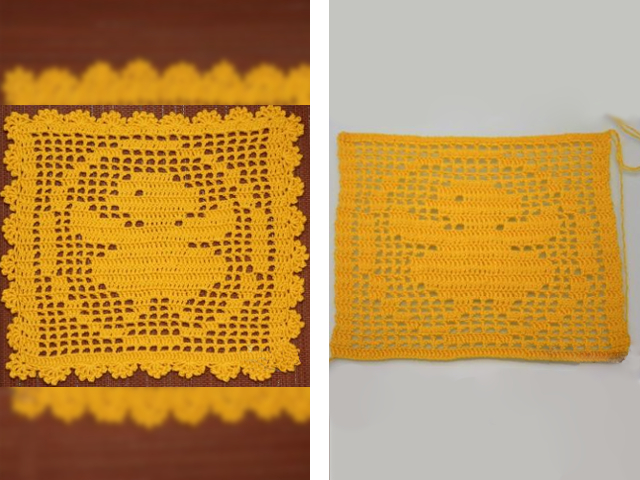
The napkin, which will look great both as a decoration during the spring holidays and will playfully decorate the nursery, will be 23*20 cm, and with a binding - 26*23 cm. This type of crochet is called fillet knitting.
Preparing to knit a napkin:
Yarn — 36 g yarn yellow color Pekhorka Tender (50 g - 150 m, 50% acrylic - 50% cotton);
Hook — №2;
Needle - blunt-ended.
Knitting pattern and description of how to crochet a napkin:

In total, we have 23 cells according to the scheme. In order to calculate the required number of VPs for the first chain, you need to multiply 23 by 3 and then add 3 more VPs for the rotation chain. Total 72 loops. And remember that a filled cell is 2 Dc inside the cell, and an empty one is 2 VP. Even rows are read from left to right, and odd rows are read from right to left.
1st row: We start knitting with a 4 chain chain, since the first cell is filled. If the cell needed to be empty, then it would be necessary to add 2 more VPs and knit into the 8th VP. We knit a DC in each loop of the chain to the end of the row. The result should be 70 CCHs, taking into account 3 lifting loops replacing the first CCH (photos 1 and 2).
2nd row: We start with 3 VP lifting, then 2 VP (this is a filled cell) and 1 more VP, then 2 VP, skip two at the base and in the third - 1 VP, and again 2 VP, in the third CV and so on until the last cell according to the scheme , which must be filled in, i.e. at the end of the row you should have 4 dc. The row ends with a DC in the 3rd chain lifting loop. In total, you should have 23 cells in the row, two of which at the edges should be filled, as in the photo below (photo 3,4,5).
3rd row: This is where the drawing begins. Let's focus on the knitting pattern. This odd row is read according to the pattern from right to left. 1 cell is filled, then 8 empty cells, 5 filled (you should get 16 CCHs), 8 empty, 1 filled. The filled cells are knitted under an arch of air loops (photo 6).
4th row: 1 cell – filled (4 CCH), 6 – empty, 2 – filled (7 CCH), 5 – empty, 2 – filled (7 CCH), 6 – empty, 1 – filled (4 CCH). The series is read from left to right. If the gaps in the filled cells are too large, this means that the loops are too loose and you need to replace the hook with a smaller size to make the knitting tighter (photo 7).
Row 18: 1 cell – filled (4 CCH), 1 – empty, 1 – filled (4 CCH), 2 – empty, 4 filled (13 CCH), 2 – empty, 2 – filled (7 CCH), 1 – empty, 4 – filled (13 dc), 2 – empty, 1 – filled (4 dc), 1 – empty, 1 – filled (4 dc). The series is read from left to right. In order to easily check whether you have missed a DC in a row, count the number of filled cells in a row, then multiply by 3 and add 1. For example, you have 10 filled cells in a row, this means that you need to knit: 10 cells * 3 DC + 1 DC = 34 dc. Accordingly, 10 filled cells are equal to the 34th CCH (photo 8).
Row 29: These are only empty cells, except for the first and last, which are the frame of our knitted chicken.
Row 30: The whole thing consists of their SSN. There should be 70 of them (photo 9).

Crochet napkin crocheting pattern and description:
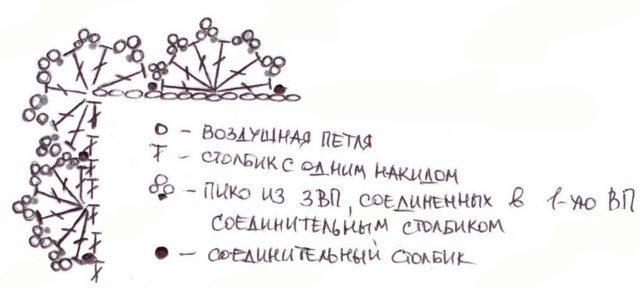
We turn the work to face us and immediately knit 1 dc in the 4th loop from the beginning, without adding lifting loops.
Having knitted the first dc, we make a picot from 3 chain stitches, fasten it with a connecting post into the first chain stitch.
Now we also fasten it into the fourth loop with a connecting post. And again in the 4th loop we knit 6 dcs with a picot.
Along the side, the fasteners and the decoration itself are attached every 2 rows into a side loop.
Tighten the loop and hide the thread using a needle with a blunt end in the knitting. Next we wash, iron and steam. After washing, all the loops will settle down, and will finally align after ironing.
Japanese
Crocheting napkins in the Japanese style is not suitable for beginner knitters, because an important part of the work lies in the complexity of the lines, loops and rings, woven into a special pattern that turns into an extraordinary floral motif. The Japanese crocheted napkin is the aerobatics of knitting, which allows you to perform very unusual napkins, interesting and original.
Napkin “Cherry Orchard”

This napkin is made up of several individual motifs.
Preparing to knit a napkin:
Yarn — White and pink iris;
Hook — №1;
Abbreviations for the diagram:
VP - air loop
PS - half-column (connecting column)
RLS - single crochet
S1H - single crochet
S2H - double crochet stitch
С3Н - double crochet stitch
Description of working on a crocheted napkin with photographs:
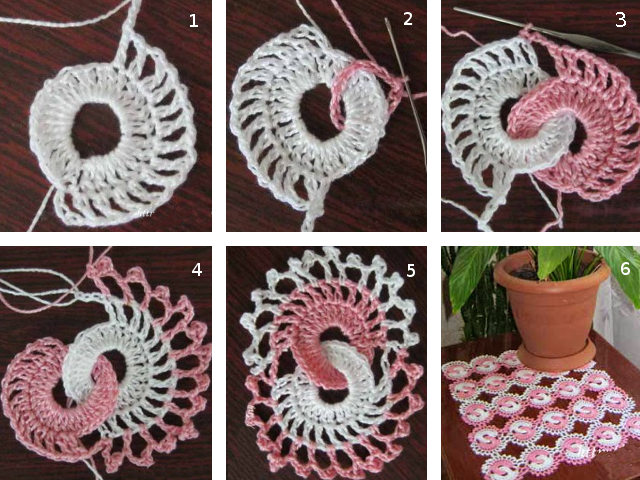
We begin knitting the motif with white yarn. We close the chain of 14 VPs into a ring with a half-column.
1st row: 3VP and 27 C1H in a ring (photo 1).
2nd row:
4VP, *С1Н, 1ВП *, С1Н – a total of 13 stitches, knitted under each loop of the 1st row.
At the end of the row, cast on 3 chain stitches and pull out a long loop so that the knitting does not unravel (photo 2).
Now we take pink yarn. We cast on 14 VP, insert the resulting chain under the white ring, close it into the ring with a half-column and knit 2 rows in the same way as with white yarn (photo 3).
3rd row: above each VP of the last row of the white ring we knit C1H, and between them - 1VP, picot from 3VP, 1VP. At the end of the row, pull out a long loop and leave knitting (photo 5).
We return to the white ring, connect it with the pink one and knit the 3rd row in the same way.
The last loop of the white ring is connected to the pink one, and the pink one to the white one.
We cut off the excess threads and carefully hide them on the wrong side, crocheting them through the loops between the rows. The result was 25 motifs, sewn together with a needle and thread (photo 6).
Napkin “Japanese motif”

Preparing to knit a napkin:
Yarn — white yarn Madame Tricote Maxi (mercerized cotton, in a skein of 100 g by 565 m);
Hook — №1;
Scheme and description of working on a crocheted napkin with photographs: 
In this Japanese napkin pattern, the even and odd rows are painted in different colors. Despite the fact that there are only 12 rows in the napkin, including the final row of single crochet, the size of the finished product is 33 cm.
1st row: Around the amigurumi ring - ch 1. and 11 tbsp. without crochet; close the row with a connecting loop (photo 1).
2nd row: 16 vp, double crochet stitch in 4 vp. the beginning of this row; a stitch with 4 crochets, knitted together with the previous stitch with 2 crochets; *7 ch, double crochet in the center of the previous 4 double crochet, double crochet, knitted together with a double crochet* - repeat from * to * until the end of the row, ch 7, double crochet 2 yarn overs in the center of the previous stitch with 4 yarn overs, close the row with a connecting stitch in the 9th loop of the beginning of this row (photo 2).

3rd row: 10 ch, double crochet, 9 double crochets, double crochet in 4th ch. the beginning of this row (photo 1). Then make 2 double crochet stitches in the center of the previous 5 crochet stitch (photos 2 and 3).

9 ch, 2 double crochets, knitted together into the 4th ch. the beginning of this row (photo 1). We knit 7 vp, * 7 tbsp. with 4 yarn overs, knitted together (photos 2 and 3).
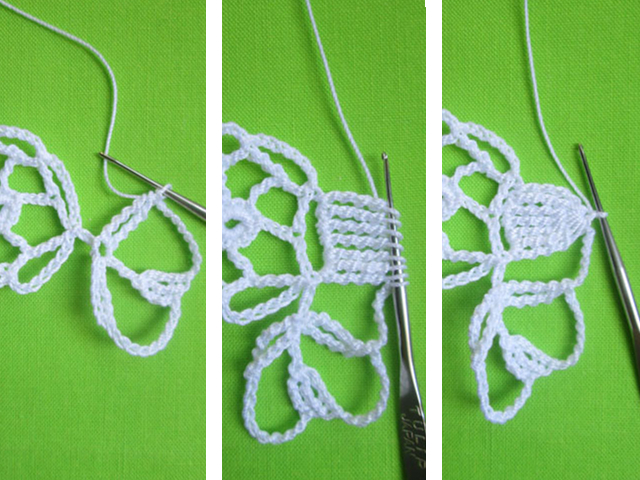
7 vp, 1 tbsp. with 6 yarn overs and 1 tbsp. with 4 yarn overs in the third yarn over of the previous stitch, knitted together.

9 vp, 1 tbsp. with 5 yarn overs, knitted into the third yarn over of a stitch with 6 yarn overs (photo 1). We knit 2 stitches with 3 yarn overs, knitted in the center of the previous stitch with 5 yarn overs (photos 2 and 3).

9 vp, 2 tbsp. with 4 yarn overs, knitted together, into the third yarn over of the same stitch with 6 yarn overs (photo 1). Then do 7 ch* - repeat from * to * until the end of the row; then - 7 ch. and close the row with a blind loop of 10 vp. the beginning of this row (photo 2).
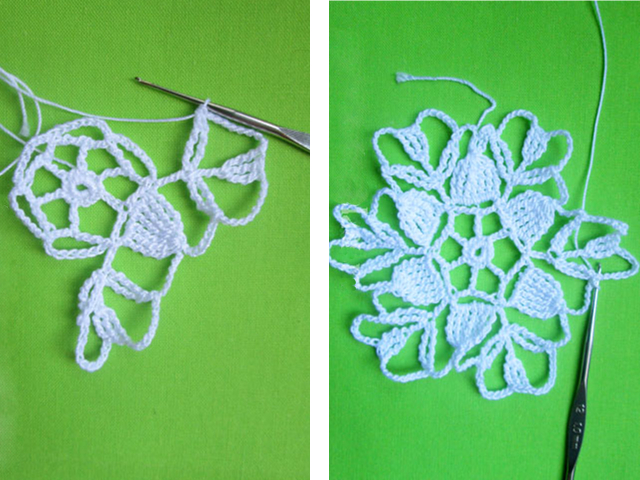
4th row: Move in half columns to the top of the flower. 5 ch, *2 tbsp. with 3 yarn overs, knitted together, 8 ch, 1 tbsp. with 4 yarn overs, of which knit only 3 and make 2 more stitches with 3 yarn overs at the same point, knit them together, and only then knit the last stitch of the stitch with 4 yarn overs*.

From * to * is a petal. 5 vp, petal, 5 vp, petal, 5 vp, petal. Next, tie 7 ch. (photo 1). The next maneuver is a tower structure designed to pull together 4 arcs from the air loops of the previous row. We knit like this. 1 tbsp. with 3 yarn overs, of which we knit only two (photo 2).

Around the next arc - a double crochet stitch (we don’t close the stitch). Repeat around the next two arcs with double crochets (photo 1). Knit all 4 stitches together and finish the primary stitch with 3 yarn overs (photo 2).
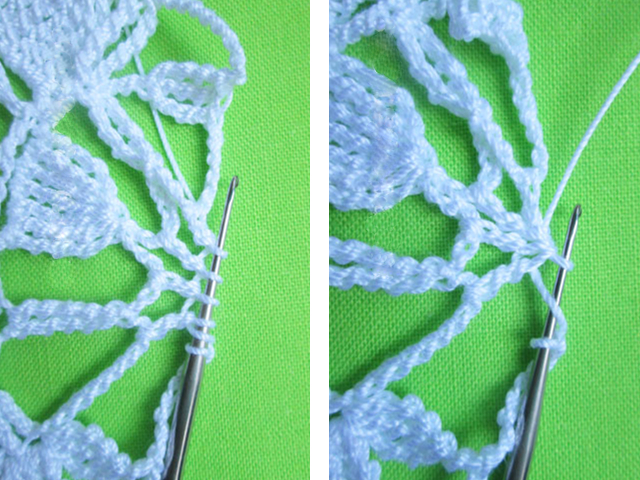
*7 vp, 5 petals separated by 5 vp; 7 vp, “tightening tower” * - repeat until the end of the row. Close the row like this: 5 vp, 1 tbsp. with 1 yarn over in the 5th chain stitch of the beginning of this row (photo). Then knit the 5th row. 3 ch, double crochet into the next arc of ch.

9 ch, *dc with 2 yarn overs, of which we knit only one; double crochet around the next arc, knitted together with the first stitch; knit the remaining double crochet stitch*. From * to * - let there be a structure with the code name “Eiffel Tower”.

Next we knit: * ch 6, Eiffel Tower * - repeat three times from * to *. Next - 7 vp, “constricting tower” - 7 vp, Eiffel Tower, * 6 vp, Eiffel Tower * - repeat from * to * 4 more times. And then again 7 vp, tightening tower, etc. to the end of the row. Close the row with a blind loop according to the diagram.
6th row: 6 ch, 2 tbsp. with 3 yarn overs, knitted together; 7 ch, 3 tbsp. with 3 double crochets in the same Eiffel Tower of the previous row + 3 tbsp. with 3 yarn overs into the next Eiffel Tower of the previous row, knitted together; 7 ch, 3 tbsp. with 3 yarn overs, knitted together, in the same Eiffel Tower of the previous row, 7 ch. and again 3 tbsp. with 3 double crochets + 3 tbsp. with 3 yarn overs into the next Eiffel Tower, knitted together. The last arc from v.p. knitted like this: 5 ch. and 1 tbsp. with 1 double crochet.
The total obtained in each Eiffel tower of the previous row is 3 petals from 3 tbsp. with 3 yarn overs, knitted together, and separated by 7 chain stitches, while at the junction of three-petal bushes, the columns of two adjacent petals are knitted together (photo 1).
7th row: 3 vp, 1 tbsp. with 1 yarn over around the next arc of the previous row, ch 10, “Eiffel Tower”, ch 7. - continue alternating 7 vp. and Eiffel towers to the end of the row. Close the row with a blind loop. Go to the top of the arc from v.p. 4 tbsp. without crochet (photo 2).
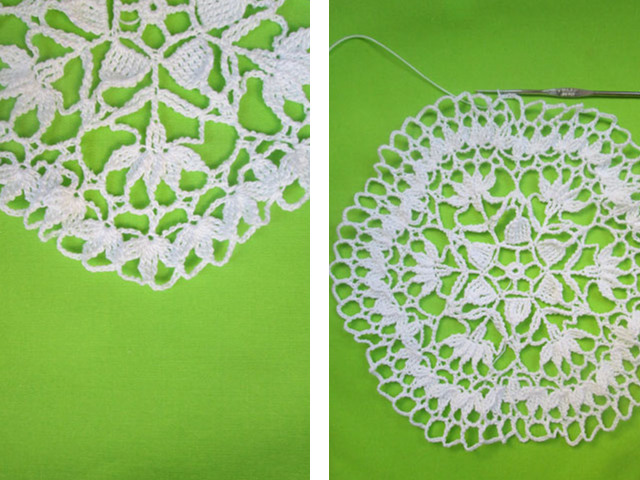
8th row: 7 ch, single crochet around the next arc, 7 ch, 1 dc. Single crochet around the next arc (photo 1). Next - 7 vp, 1 tbsp. with 5 yarn overs to the Eiffel Tower (photo 2,3).
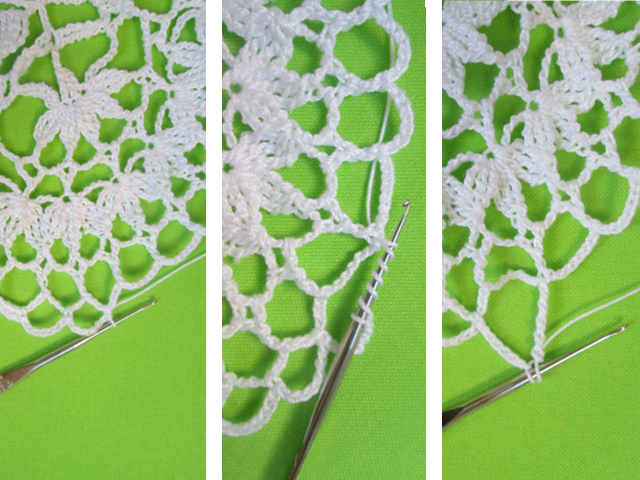
1 tbsp. with 3 yarn overs in the center of the column with 5 yarn overs - then knit them together.

6 vp, 1 tbsp. with 5 crochets in the center of the column with 5 crochets. 2 tbsp. with 3 yarn overs in the center of the last stitch with 5 yarn overs, ch 6 (photo 1). 2 tbsp. with 3 crochets, knitted together, in the center of the first stitch with 5 crochets of this complex design(photo 2).

Repeat all steps in the description of this row until the end of the row. Close the row with a blind loop, go 4 tbsp. without crochet to the top of the arc.
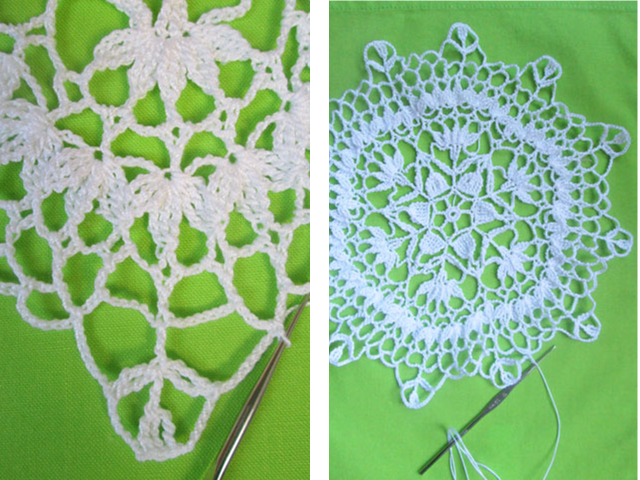
9th row: 3 ch, 5 tbsp. with 2 double crochets, knitted together, ch 3, single crochet around the arc. 5 ch, Eiffel Tower (photo 1). 5 v.p. and move on to knitting the petal: a stitch with 4 yarn overs, of which we knit only three, then 2 tbsp. with 3 yarn overs, knitted together with the first; tie a stitch with 4 crochets - the petal is ready. We knit five such petals, separating them with 5 vp. After all the petals - 5 ch, Eiffel Tower, 5 ch, single crochet and repeat all steps from the beginning of this row to the end of the row. Close a row of blind loops. Go to the top of the element filled with 5 tbsp. with 2 double crochets, knitted together, single crochet (photo 2,3).

10th row: Ch 4, single crochet around the next arc, ch 5, single crochet around the next arc, ch 5, single crochet around the next arc, ch 4, single crochet around that same arc, 5 vp, single crochet around the next arc, 4 vp, single crochet around the same arc, 5 vp, single crochet around the next arc, 4 vp, dc single crochet around the same arc, ch 5, single crochet around the next arc, ch 4, single crochet around the same arc, ch 5, single crochet around the next arc, 5 in. p., single crochet around the next arc, 4 ch, single crochet at the top of the diamond of the previous row. Repeat from the beginning of the description to the end of the row, but instead of the last 5 ch. - 2 v.p. + 1 tbsp. with 1 double crochet.
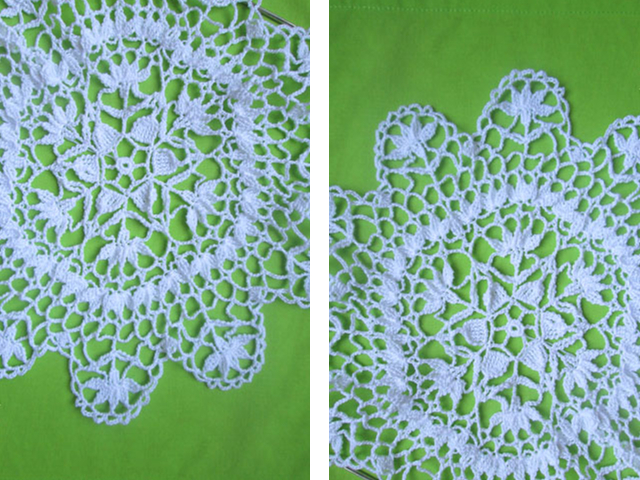
11th row: This row is mainly made up of a lift from the tenth row, and if you master it (the lift), consider that a Japanese napkin is in your pocket. 3 vp, 1 tbsp. with 1 yarn over around the next arc. Next: ch 4, unfold the napkin. Now we knit in the other direction: 1 tbsp. with 3 yarn overs around the next arc, of which we knit only the first, then 1 tbsp. with 1 crochet around the next arc, knit together, finish with a stitch with 3 crochets. We unfold the napkin to its normal state and knit again counterclockwise. 1 tbsp. with 3 yarn overs, of which we knit only one, 1 tbsp. with 1 crochet around the next arc, knit together, finish with a stitch with 3 crochets. It turns out to be an Eiffel Tower, only the top is made up of not one, but two yarn overs. We tie all the arches of the flower with such grown ones Eiffel towers, separated by five chain stitches (photo 1).
Then we move on to the junction of the flowers. To do this, we knit (according to the diagram): 4 ch, 1 stitch with 4 crochets, of which we knit only one, then a stitch with 1 crochet around the next arc, knit together with the previous stitch and then we knit two more yarn overs from the stitch with 4 yarn overs. Next, a stitch with 3 yarn overs around the next arc, of which we knit only one yarn over. Double crochet around the next arc, knit the stitches together, tie the remaining two double crochets. We continue to knit another Eiffel tower around the next two arcs of air loops (photo 2).
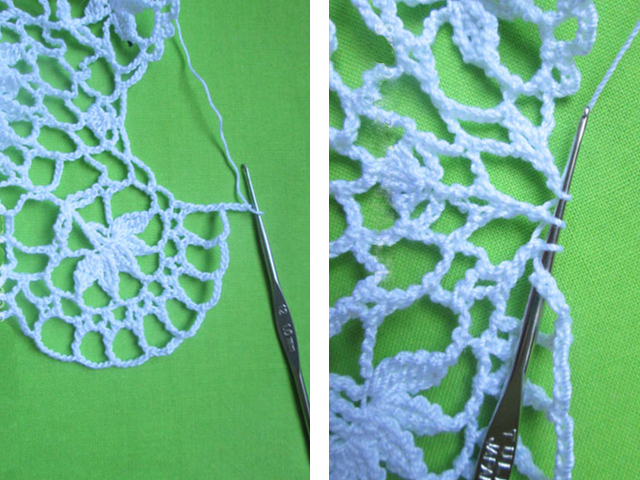
We knit three Eiffel towers together, knit the last yarn over of the primary stitch with 4 yarn overs (photo 1,2). Again 4 ch. and tie the flower with Eiffel towers. We finish the row with a blind loop (photo 3).
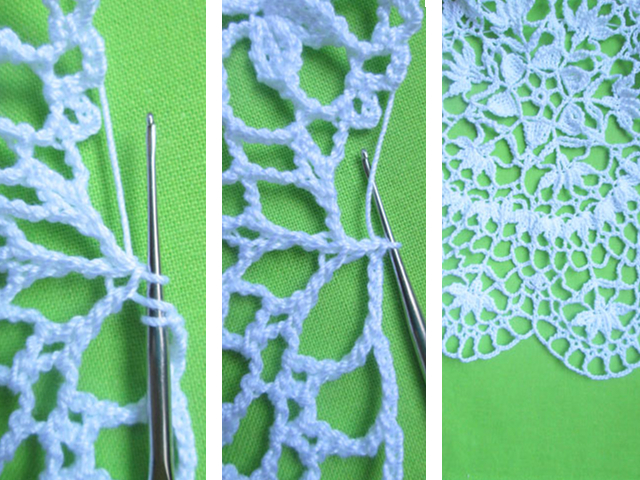
Row 12: We tie the row with double crochets. We start the row like this: 4 tbsp. without crochet around the arc; 4 tbsp. Single crochet around the next arc, picot of 4 ch. (4 ch + blind loop in the first ch of this picot), 4 tbsp. without a crochet around the same arc. In this way we tie all the arcs, with the exception of the junction of the flowers: here we knit 4 tbsp for each arc. without a crochet and do not make a picot (photo 1). The crocheted Japanese napkin is ready. We moisten, straighten, attach with pins (while the napkin itself lies face down!), iron with steam and leave to dry straightened (photo 2).
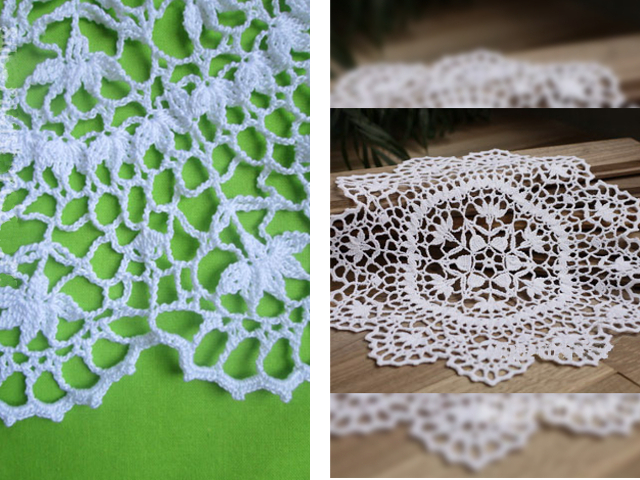
Openwork
Very popular and beloved by housewives, crocheted napkins are beautiful openwork napkins, so airy and delicate that they look like clouds. You don’t even want to put anything else on such napkins; they don’t need additional decorations. Every needlewoman should learn how to knit such lace motifs, and detailed diagrams and descriptions of openwork napkins will help with this.
Napkin "Spring"
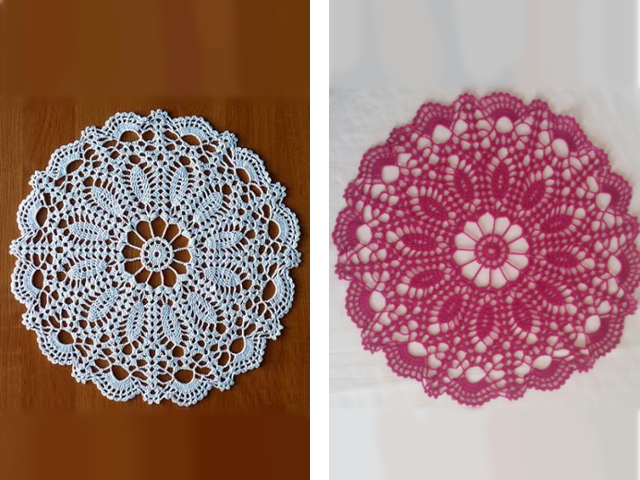
The finished napkin will have a diameter of 41 cm, and will definitely delight all household members with its beauty for a long time.
Preparing to knit a napkin:
Yarn — Pekhorka, white, Successful, 100% cotton, 50 g – 220 m
Hook — №2.
Abbreviations for the diagram:
Dc
– double crochet;
Sc
– single crochet;
VP
- air loop;
Sp
– connecting loop;
S5N
– a column with 5 crochets;
S2H
- double crochet stitch.
Knitting pattern and description of how to crochet a napkin:

1st row: into the ring we knit 3 Ch, 23 Dc, connect Sp;
2nd row: 3 Ch + 3 Ch, 1 Dc in the 4th loop from the hook, * skip one loop - 1 Dc, 3 Ch, 1 Dc in the base of the column (see diagram) *, ending with Sp;
3rd row: 7 Ch + 9 Ch, * 1 C5H in the column of the 2nd row, 9 Ch *, ending with Sp in the 7th Ch;
4th row: Sp, 3 Ch (equal to the first double crochet), 4 dc, 5 ch, 5 dc*, ending with sp;
5 row: *4 Ch (equal to 1C2H) + 7 Ch, 1 C2H in the same loop, in the arch - 3 Dc, 5 Ch, 3 Dc*, repeat, finishing row Sp;
6th row: *4 Sp to the middle of the arch, 3 Ch (equal to the first double crochet), 4 Dc, 1 Ch, under the arch 3 Dc, 5 Ch, 3 Dc, 1 Ch*, ending with Sp;
7th row: *3 Ch (equal to the first double crochet), 1 dc, in one base of the column we knit 1 dc, 1 ch, 1 dc, 2 dc, 1 ch, under the arch 3 dc, 5 ch, 3 dc, 1 ch *, finish Sp;
8th row:
9th row: 3 ch (equal to the first double crochet), 2 dc, 2 ch, 3 dc, 3 ch, under the arch 3 dc, 5 ch, 3 dc, 3 ch *, finish with sp;
10th row: 3 ch (equal to the first double crochet), 2 dc, 2 ch, 3 dc, 1 ch, under the arch 3 dc, 5 ch, 3 dc, 1 ch *, finish with sp;
11th row: *3 Ch (equal to the first double crochet), 2 dc, 1 ch, 3 dc, 3 ch, under the arch 3 dc, 5 ch, 3 dc, 5 ch, 3 dc, 3 ch*, ending with Sp.
We knit the remaining rows of the napkin according to the pattern.
Napkin “Summer Meadow”

Preparing to knit a napkin:
Yarn — 40 g of “Successful” yarn from “Pekhorka”, yellow, 100% cotton (50 g – 220 m);
Hook — №2.
Abbreviations for the diagram:
Etc.
– previous row;
CCH
– double crochet;
VP
- air loop;
SS
– connecting column;
RLS
– single crochet;
Pico
– we knit from three VPs;
СС2Н
- double crochet stitch.
Knitting pattern and description of how to crochet a napkin:

We start each row with 3 VPs, they are equal to 1 Dc. We end with SS, unless otherwise indicated in the text.
We collect eight VPs and connect them into an SS ring.
1st row: 3VP, 23СН;
2nd row: 3VP, 4VP *2DC with a common top, we knit one in the same loop, the second through one, 4VP*;
3rd row: 3VP, 4СН (into the arch from VP, p.r.), 1VP * 5СН (into the arch from VP, p.r.), 1VP*;
4th row: 3VP, 4CCH at the tops of the CCH, p.r., 3VP * 5CCH at the tops of the CCH, p.r., 3VP*;
5 row: knitted in the same way as the 4th, but in the intervals between dcs we knit 4 chain stitches;
6th row: 3VP, 4CCH at the tops of the CCH, p.r., 2VP, 1CCH under the arch from the VP, p.r., 2VP *5CCH, 2VP, under the arch 1CCH, 2VP*;
7th row: 3VP, 4CCH in the tops of the CCH, p.r., 2VP, 3CCH in the CCH, p.r., 2VP * 5CCH, 2VP, 3CCH in the column, p.r., 2VP*;
8th row: 3VP, 4DC in the vertices of the DCS, 2VP, 2DC in the first two DCS, 1VP, 2DC (1st again in the 2nd SSN of the previous row, and 2nd in the 3rd DCS, 2VP * 5DC, 2VP , 2СН, 1ВП, 1СН, in the same loop, 1СН in the next one, 2ВП*;
9th row: 3VP, 4CCH at the tops of the CCH p.r., 2VP, 2CCH, 3VP, 2CCH, 2VP * 5CCH, 2VP, 2CCH, 3VP, 2CCH, 2VP*;
10th row: knitted similarly to the 9th row, but instead of 3 VPs between the DCs, now 5 are knitted;
11th row: 3VP, 2СН, 2СН with a common top, 2VP, 2СН in the ССН p.r., 2VP, in the 3rd VP p.r. 3DC, 2VP, 2DC, 2VP *2DC with a common top, 1DC, 2DC with a common top, 2VP, 2DC, 2VP, 3DC in the 3rd VP, 2VP, 2DC, 2VP *1DC in the 3rd VP, 1DC in the 1DC row;
Row 12: 3VP, 2CCH with a common vertex in 2CCH, p.r., 2VP, 2CCH in each CCH, p.r., 2VP, 2CCH in the 1st CCH, p.r., 1CCH, 2CCH in the 3rd CCH, p.r., 2VP, by 2Dc in each dc p.p., 2 VP * 3 dc with a common top, 2 ch, in the next two loops 2 dc, 2 ch, in the next three loops - 2 dc (from the 1st dc), 1 dc (from the 2nd dc), 2 dc (from the 3rd CCH), 2 VP, in 2CCH p.r. 2DC, 2VP * 1DC in 3VP of the beginning of the row and 4DC in each next loop;
Row 13: 3VP, 1CCH in the 2nd CCH, p.r., 2VP, 2CCH in both CCHs, p.r., 2VP, 5CCH, (2CCH, 2VP, 2CCH) – in the 4th CCH, p.r. *2СН, 2ВП, 2СН, 2ВП, 5СН, 2ВП, 2СН, 2ВП, 2СН*;
Row 14: 3VP, 1DC, 5VP * 2DC, 2VP, 5DC, 2VP, 2DC, 5VP, 4DC with a common top, 5VP*, 1DC in the 3rd VP and another 7DC in the next loops;
Row 15: 3ВП, 1СН,2ВП, 5СН, 2ВП, 2СН, 13ВП *2СН, 2ВП, 5СН, 2ВП, 2СН, 13ВП*;
Row 16: 3VP, 1SSN, 2VP, 5SSN, 2VP, 2SSN, 6VP, 1SBN in the 7th VP of the arch, p.r., 6VP *2SSN, 2VP, 5SSN, 2VP, 2SSN, 6VP, 1SBN in the 7th VP, p.r., 6VP*;
Row 17: knitted similarly to row 16, but now not 1 sc between 6 VPs, but 3 sc, i.e. one more on each side to the neighboring VP p.r. But the number of framing VPs also remains 6 (six);
Row 18: knitted similarly to row 17, but sc is now 5, i.e. one more on each side, and they are framed not by 6 VPs, but by 7;
Row 19: 3VP, 1DC, 2VP, 2DC with a common vertex, 1DC in the third VP, 2DC with a common vertex, 2VP, 2DC, 7VP, 1SC in the 7th VP, 13VP, 1SC in the 1st VP, PR. , 7VP *2DC, 2VP, in the next five loops - 2DC with a common top, 1DC, 2DC with a common top, 2VP, 2DC, 7VP, 1SC in the 7th VP p.r., 13VP, 1SC in the 1st VP p.r. ., 7VP*;
Row 20: 3VP, 1DC, 2VP, 3DC with a common top, 2VP, 2DC, 7VP, in the arch between the RLS p.r. we knit 13DC, 7VP * 2DC, 2VP, 3DC with a common top, 2VP, 2DC, 7VP, 13DC, 7VP*;
Row 21: 3VP, 1Dc in dc, p.r., then 2dc in the next 2dc, p.r. (i.e., we skip the dc with a common top in the row), 7 VP, 1 sc in the 1st dc in the row, we knit 2 ch, 1 sc, skipping one loop in the row. We knit this way until the fan from the SSN p.r. is finished. 7VP *2DC, knit the next 2DC in 2DC, p.r., 7VP, 1SC, (2VP, 1SC) – 6 times, 7VP *;
Row 22: 3VP, 3SSN with a common top, 7VP, in all arches from VP between RLS p.r. we knit 4CC2H with a common top, 3VP, picot, 3VP. We finish 4 СС2Н with a common vertex, then we knit 7 VP * 4 ССН with a common vertex, 7 VP, 4 СС2Н, (3 VP, picot, 3 VP, 4 СС2Н) – 5 times, 7 VP *.
Video lesson - knitting for beginners
For beginners in crocheting, it is always more difficult to navigate difficult patterns and descriptions of actions the first time, especially in such a difficult task as knitting napkins. But you can take help from professionals on the Internet in this matter. Videos from professional knitters will help you knit your first napkin much faster.
Video lesson for beginners “how to crochet a napkin”:
